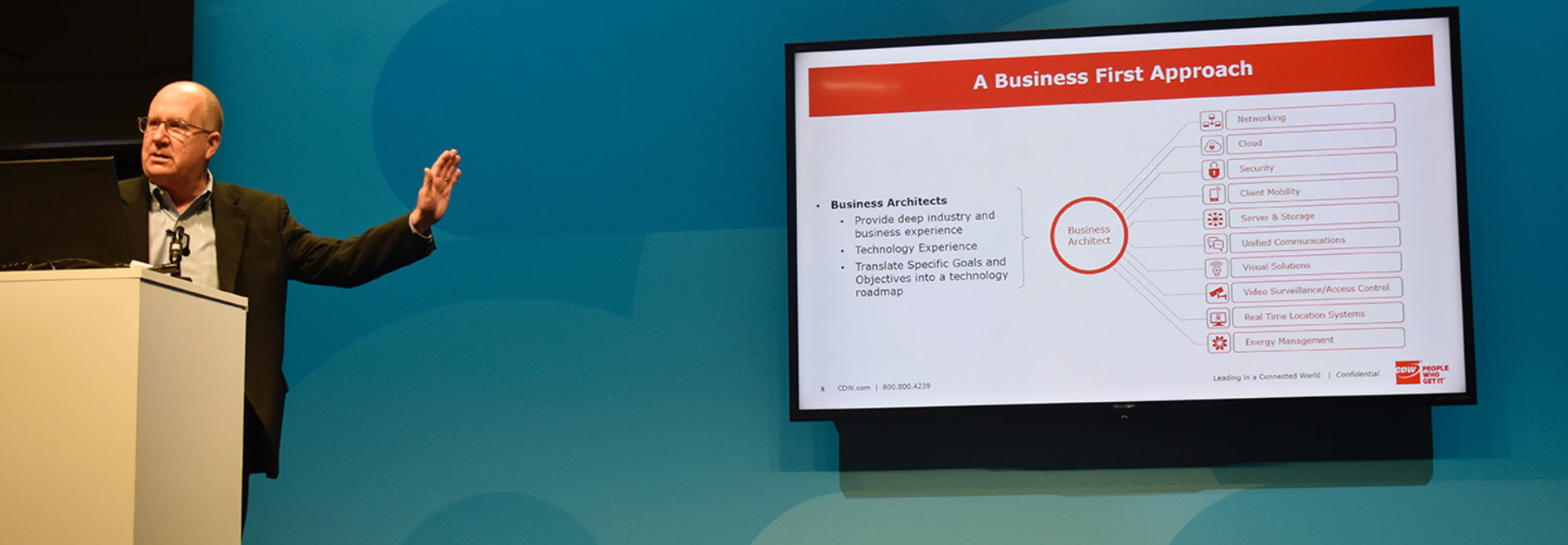Cisco Live 2017: Digital Transformation Is Complex and Requires Partnerships
The Internet of Things and digital transformation can sometimes seem like amorphous terms to many businesses. However, to take advantage of IoT and use technology to transform their business models, organizations need some tried-and-true aspects of business: a clear plan and solid partners.
Those were a few of the key takeaways from Link Simpson, the IoT and digital transformation practice lead at CDW, during a presentation Monday at the Cisco Live 2017 conference in Las Vegas.
Although $6 trillion is expected to be spent on IoT by 2021, yielding $14.2 trillion in economic activity by 2030, businesses report that 60 percent of IoT initiatives are stalling at the proof-of-concept phase, according to a Cisco Systems survey.
IoT involves the instrumentation of the physical world with sensors, and analytics can sift through that data for insights. Digital transformation involves using IoT and IT to change business models — better cost efficiency and return on investment, lower costs and improved customer experience and business processes.
“Digital transformation is an extremely complex subject to address,” Simpson says.
Develop a Clear Plan for Digital Transformation
First and foremost, Simpson says, if a company is going to transform its business model, its leaders need to know what they are going to transform from and into. “So there’s a lot of work that has to be done to figure out where you want to go as a business,” he says.
Simpson advises that companies take “a business-first approach” to digital transformation.
“You have to figure out what the businesses’ goals and objectives are in terms of where they are trying to go and translate them into those technologies,” he said, including networking, cloud, security, client mobility servers and storage, unified communications, visual solutions, access control, real-time location systems and energy management.
In addition to business goals and objectives, business and IT leaders need to take a variety of factors into account:
- Existing IT infrastructure and applications
- Existing operating technology with multiple protocols and interfaces
- New sensors and data collection capabilities
- Cloud services • Specialized analytics capabilities
- Comprehensive security
- Services expertise for design and implementation
- Ongoing support and management
CDW’s approach is to tap business architects who understand a specific industry and can bring together subject-matter experts from all those various technologies “so that you can effectively assimilate and pull together all of those solutions to address a comprehensive transformation process.”
Businesses should also use a standard model of deploying IoT solutions to future-proof other solutions. For example, a layered approach of physical devices and controllers, connectivity, edge computing, data accumulation, data abstraction, applications, and collaboration and processes can help businesses reproduce IoT deployments down the road.
“If we structure it in a common format, we can add additional solutions on top of the early solutions in a way that you can still continue to provide consistency and allows you to grow,” without shutting down earlier IoT solutions, Simpson says.
Partners Are Key to Digital Transformation
Without partnerships, digital transformations are likely to stall, Simpson says. “No matter how good an organization is, they typically are going to not have all of the skills and all of the expertise because of that complexity,” he says.
Businesses need not just their traditional IT partners, but also partners for new operational technology, cloud and Software as a Service, analytics, application development and implementation services.
“Digital transformation is a journey,” Simpson says. “Nobody [but you] can define where you need to go. You are going to have to get into the game with your partners, with your IT organization,” and define goals, objectives and challenges.
Organizations also need to take into account the human and cultural aspects of their companies to be successful, Simpson notes. “Nobody knows your business or organization better than you do,” he says.
Companies should look to “choose a partner that has the breadth of services to be able to handle that complexity for you and can orchestrate all of that complexity into simplicity. Somebody that has got a team of experts that understands your industry so that they can do that translation between your business goals and objectives and the technology.”
Read articles and check out videos from BizTech coverage of Cisco Live 2017 here.









